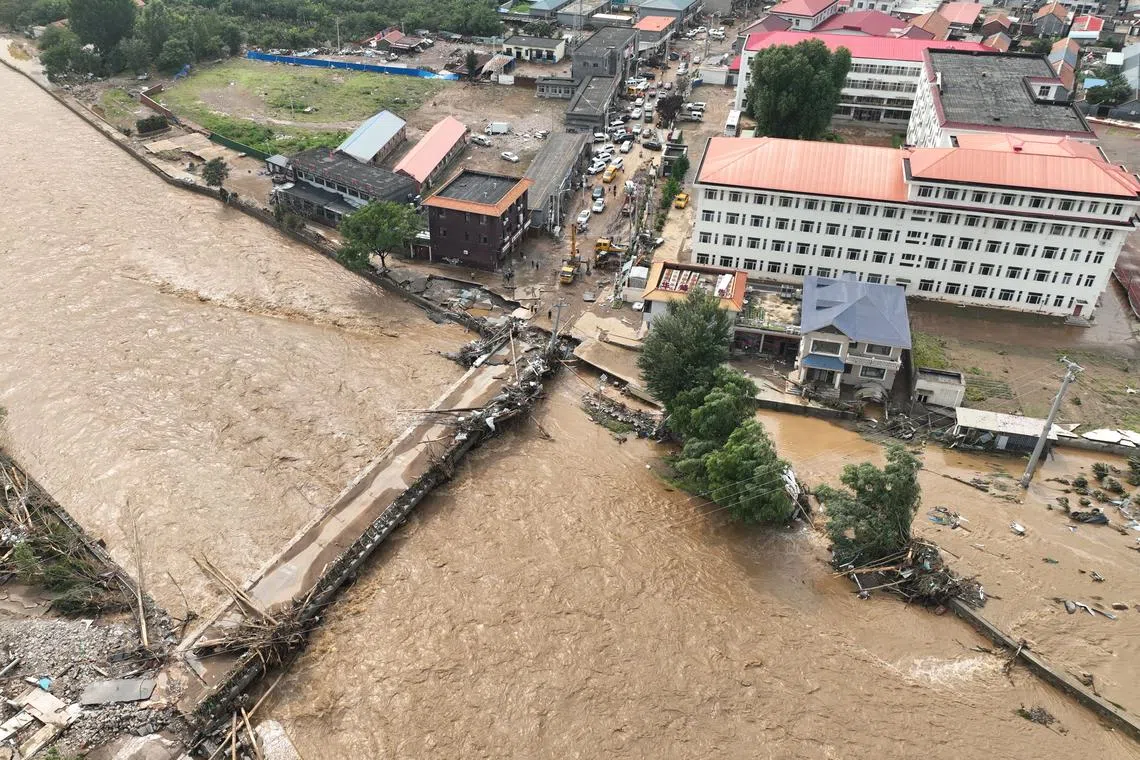Extreme weather turns Beijing into rain trap; 30 killed, over 80,000 evacuated
Sign up now: Get insights on Asia's fast-moving developments
Follow topic:
BEIJING – Thirty people have been killed in Beijing and over 80,000 evacuated as at midnight on July 29, after almost a year’s worth of rain hit the capital in a matter of days, prompting some experts to call the city a rain trap.
The deaths were reported in Beijing’s mountainous northern districts near the Great Wall, with 28 in Miyun and two in Yanqing. State media did not specify when or how the deaths occurred.
Heavy rain started on July 23 and intensified around Beijing
The average annual rainfall in Beijing is around 600mm.
“The cumulative amount of precipitation has been extremely high, reaching 80 to 90 per cent of the annual total in just a few days in some areas,” said Dr Zhang Xuebin of the University of Victoria in Canada and chief executive of the Pacific Climate Impacts Consortium.
“Very few systems are designed to handle such an intense volume of rainfall over such a short period.”
The local topography – mountains to the west and north – “trapped” the moist air and forced it to rise, enhancing the extraordinary amount of precipitation, he added.
The most intense rain occurred on July 26 in Beijing’s hilly Huairou, which saw 95.3mm of rain in one hour.
Over 80,000 people have been evacuated in the Chinese capital alone and dozens of roads have been closed, with over 130 villages losing electricity, according to Beijing Daily.
“Please pay attention to weather forecasts and warnings, and do not go to risk areas unless necessary,” the media outlet said.
Also badly affected were Huairou district in the north of the city and Fangshan in the south-west, state media said.
In Miyun, a resident surnamed Liu said he watched flood waters sweep away vehicles outside his apartment block on early Monday morning. AFP journalists on the scene saw a crawler lifting people and a dog to safety, as rescuers waded through water up to their knees.
Nearby, in the town of Mujiayu, AFP journalists saw a reservoir release a torrent of water.

Flood waters inundating a road and bridge in Jizhou district, Tianjin, northern China, on July 28.
PHOTO: EPA
Power lines were swept away by muddy currents, while military vehicles and ambulances ploughed flooded streets. Firefighters rescued 48 people trapped in a senior care centre, state broadcaster China Central Television (CCTV) reported.
On July 29, parks, libraries and museums including the Palace Museum at the Forbidden City were closed. Train and bus services in the suburbs and along waterways were suspended. Hundreds of flights were cancelled or delayed at Beijing’s two airports, state media reported.
All-out efforts
Chinese President Xi Jinping urged the authorities late on July 28 to plan for worst-case scenarios and rush the relocation of residents in flood-threatened areas.
Chinese Premier Li Qiang said heavy rain and flooding in Beijing’s Miyun district had caused “significant casualties”, according to Xinhua.
Beijing Daily said local officials had “made all-out efforts to search and rescue missing persons... and made every effort to reduce casualties”.
In Hebei province, which encircles the capital, a landslide in a village near the city of Chengde killed four people, with eight still missing, CCTV reported on July 28.
More than 730 million cubic m of water has flowed into the Miyun Reservoir – the largest in China’s north – as at July 29 morning, and 120 million cubic m has been discharged since July 27 afternoon.
Beijing is urging residents to keep clear of downstream rivers whose water levels are expected to remain high.
China’s National Development and Reform Commission said on July 29 that it was urgently arranging 200 million yuan (S$35.8 million) to support Beijing in its flood relief efforts.
The funds will mainly be used to repair damaged transportation, water, medical and other infrastructure and public service facilities in Miyun and Huairou, the commission said.
The Finance Ministry also allocated 350 million yuan on July 29 to aid disaster relief efforts in Beijing and other provinces.
Natural disasters are common across China, particularly in the summer when some regions experience heavy rain while others bake in searing heat.
The country is the world’s biggest emitter of greenhouse gases, which scientists say drive climate change and contribute to making extreme weather more frequent and intense.
But it is also a global renewable energy powerhouse that aims to make its massive economy carbon-neutral by 2060.
Separately, flash floods in the eastern Shandong province killed two people and left 10 missing in July.
Also, a landslide on a highway in Sichuan province in July killed five people after it swept several cars down a mountainside. AFP, REUTERS

